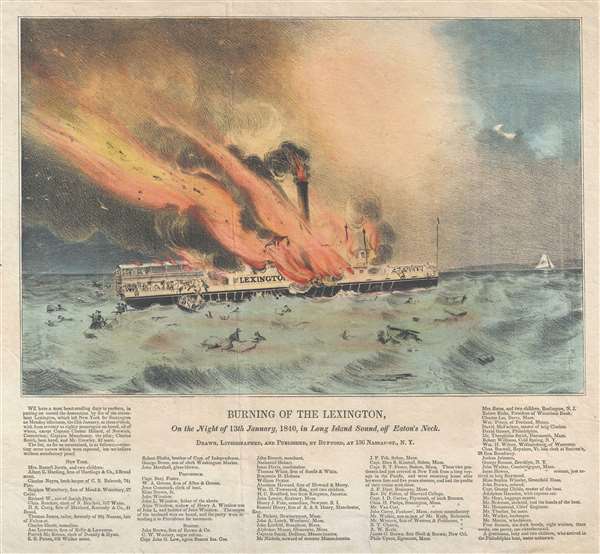This item has been sold, but you can get on the Waitlist to be notified if another example becomes available, or purchase a digital scan.
1840 Bufford View of the Burning of the Lexington, Long Island, New York
BurningLexington-bufford-1840
Title
1840 (dated) 12.5 x 13.5 in (31.75 x 34.29 cm)
Description
The view illustrates the chaos that ensued following the outbreak of the fire, with numerous passengers illustrated in the water and the full-to-bursting lifeboats that would eventually sink due to the number of people that had crammed into them. The Lexington, along with its passengers, was carrying a cargo of bales of cotton, which were in the end her demise. The cotton had been stored inexplicably close to the smokestack, which caught fire halfway through the voyage to Stonington, and ignited the bales of cotton. The fire burned through the drive-rope, making the Lexington unnavigable, leaving her to drift out to sea. By midnight, those left on board were forced to jump into the frigid water and died of hypothermia. The Lexington sank by 3:00 a.m.
This view was drawn, lithographed, and published by John Henry Bufford in 1840.
Cartographer
John Henry Bufford (July 27, 1810 - October 8, 1870) was a Boston based lithographer and printer. Bufford was born in Portsmouth, New Hampshire. He apprenticed as an artist and lithographer at Pendleton Lithography (1825 - 1836) of Boston. In 1835 he relocated to New York where he took independent commissions from George Endicott and Nathaniel Currier, among others. Returning to his hometown of Boston in 1839, he took a position of chief artist with the firm of Benjamin W. Thayer, heir to Pendleton Lithography. He probably married Thayer's sister, Anna Melora Tufts Thayer (1808-1878). Bufford has been highly criticized as an engraver, with one historian, David Tatham, stating he had 'a mediocre sort of craftsmanship at best' and 'no very special skills as an original artist.' We, however, find no justification for this harsh criticism. Instead Bufford gravitated toward business and management. By 1844 Thayer's shop was renamed J. H. Bufford and Company. The firm specialized in decorative sheet music, panoramic views, illustrations for books, retractions of paintings, and commercial printing. Bufford is credited with being one of the first employers and mentors of the important artist and engraver Winslow Homer. Bufford died in 1870, passing on the business to his sons Frank G. Bufford and John Henry Bufford Jr. These young men, operating under the imprint of 'J.H. Bufford's Sons, Manufacturing Publishers of Novelties in Fine Arts', expanded the firm with offices in New York and Chicago. A possibly related lithographic printing firm named Bufford Chandler was incorporated in Boston in 1893. It later relocated to Concord, New Hampshire but closed in 1925 when its state business charter was repealed. More by this mapmaker...

